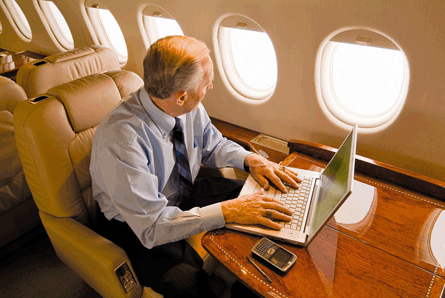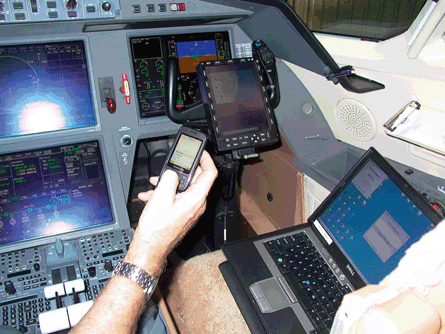Connectivity solutions that enable passengers to send and receive text messages and email, browse the internet and make cell phone calls during flight are being adopted on a broad scale by airlines across the globe. But while commercial take-up of in-flight connectivity has dominated the headlines, business aviation represents a viable growth sector for airborne communications providers as technological advancements have expanded options for operators.
This paradigm was underscored today by Aircell's announcement that Lisbon-headquartered private jet club Jet Republic has selected the US firm's SwiftBroadband solution for its entire fleet of 110 Bombardier Learjet 60XR aircraft. The deal marks the largest SwiftBroadband system order ever placed.
Powered by Thrane & Thrane, Aircell's satellite-based SwiftBroadband solution harnesses Inmarsat's higher-bandwidth aeronautical service, which provides a pipe to the aircraft that can be used for cockpit, cabin and operational applications nearly anywhere on Earth.
 |
|---|
© Aircell |
"For customers with global connectivity needs, our new SwiftBroadband system is the very latest in affordable communications - and a dramatic leap forward from earlier generations of technology," says Aircell senior vice-president, business aviation solutions Andrew Geist.
The SwiftBroadband product interfaces with Aircell's network-neutral Axxess cabin system, which comprises an aircraft wireless hotspot, wired and wireless telephony handsets, PBX (private brand exchange) switching, and other in-cabin functions. Axxess comes standard with two built-in channels of Iridium satellite communications.
"We currently sell Axxess, the base system, at almost every original equipment manufacturer as either standard or a production option and that goes from the Gulfstream G550 business jet all the way down to a Beechcraft King Air turboprop and Cessna," says Geist.
Installing the Axxess system with Aircell's SwiftBroadband solution as an add-on "would be the best solution" for business aviation operators outside the USA since a dedicated air-to-ground (ATG) network is not in place. For Jet Republic, the combined offering will enable its members "to keep in touch with the world, even from 51,000ft", says founder and chief executive Jonathan Breeze.
In the USA, where Aircell operates an ATG network, the combination of Axxess and the company's high-speed internet offering, dubbed the Aircell ATG 4000, is expected to be more compelling to operators, as it allows passengers and crew to use their own 802.11b/g-equipped wi-fi data devices - laptops, personal digital assistants, BlackBerrys and portable gaming systems - to check email, tap into an office network and do "hard-core web surfing", says Geist.
The commercial airline version of the service - known as Gogo - has already been selected by airlines representing more than half of the North American mainline market. The system is flying with American Airlines, Delta Air Lines and Virgin America, and is set to be installed on aircraft operated by Air Canada, Delta's merger partner Northwest Airlines and United Airlines, among other undisclosed customers.
 |
|---|
© Aircell |
Of its Axxess clients in the business aviation world, Aircell says there is a "very good base" that has either been interested in high-speed internet "for quite some time" or is now "becoming interested in it".
Some operators are looking at putting all three systems - the baseline Axxess system, the SwiftBroadband solution, and the Aircell ATG 4000 on aircraft that fly internationally.
The first shipsets of the Aircell ATG 4000 will be available in July, two months earlier than originally planned due to "pent-up demand", says Geist.
Helping to spur this interest is the minimal weight of the Aircell ATG 4000. "When you look at the equipment package that goes on a business jet, the total weight - if you include all components of the Axxess and Aircell ATG 4000 systems - is 23lb [10.4kg] in total," says Geist.
"When you think of the dramatic change that represents from the Ku-band-based systems, it has really opened the market for a lot of folks."
Such an offering will no doubt pose competition to Arinc Direct's Ku-band service for business jets called SkyLink, which provides broadband links to aircraft equipped with Rockwell Collins' eXchange product line.
Rockwell Collins, provider of the aircraft systems, and Arinc joined forces for the service in January 2008, a move necessitated by the demise in 2006 of Connexion by Boeing, Rockwell Collins' original choice for a broadband satellite services provider.
But other providers of less sophisticated offerings are ready to make their mark in the business aviation community. Asiq chief executive Ron Chapman has invented a patent-pending system called SafeCell that is being billed as an alternative approach for corporate jet passengers to use their cell phones on board aircraft "without the requirement for installing complex and expensive GSM Picocell network infrastructure and jamming systems".
SafeCell is a software application installed on a cell phone, which operates in flight or offline mode and takes control of the cell phone to communicate via Bluetooth.
"If you already have an Iridium system - 18,000 aircraft do - Asiq has developed a simple solution using a laptop or UMPC [ultra-mobile PC] with Bluetooth dongle. The system works just the same as a permanent installation and has been in operation now for three months on a Dassault Falcon 2000EX," says Chapman, noting, however, that SafeCell is "satellite-link neutral" in that it can be operated over Iridium, Thuraya, and other satellites.
At this stage, SafeCell allows text, email and news text updates into the aircraft. The ability to provide voice has also been added, says Chapman. A voice call via SafeCell costs $1 per minute, while SMS starts at 25¢.
Chapman believes the offering has global appeal. "When you look at cell phones globally, only 10% have wi-fi, while 90% have Bluetooth. Admittedly in the USA, wi-fi is probably more prolific, but still it's probably only 20%."
Source: Flight Daily News























